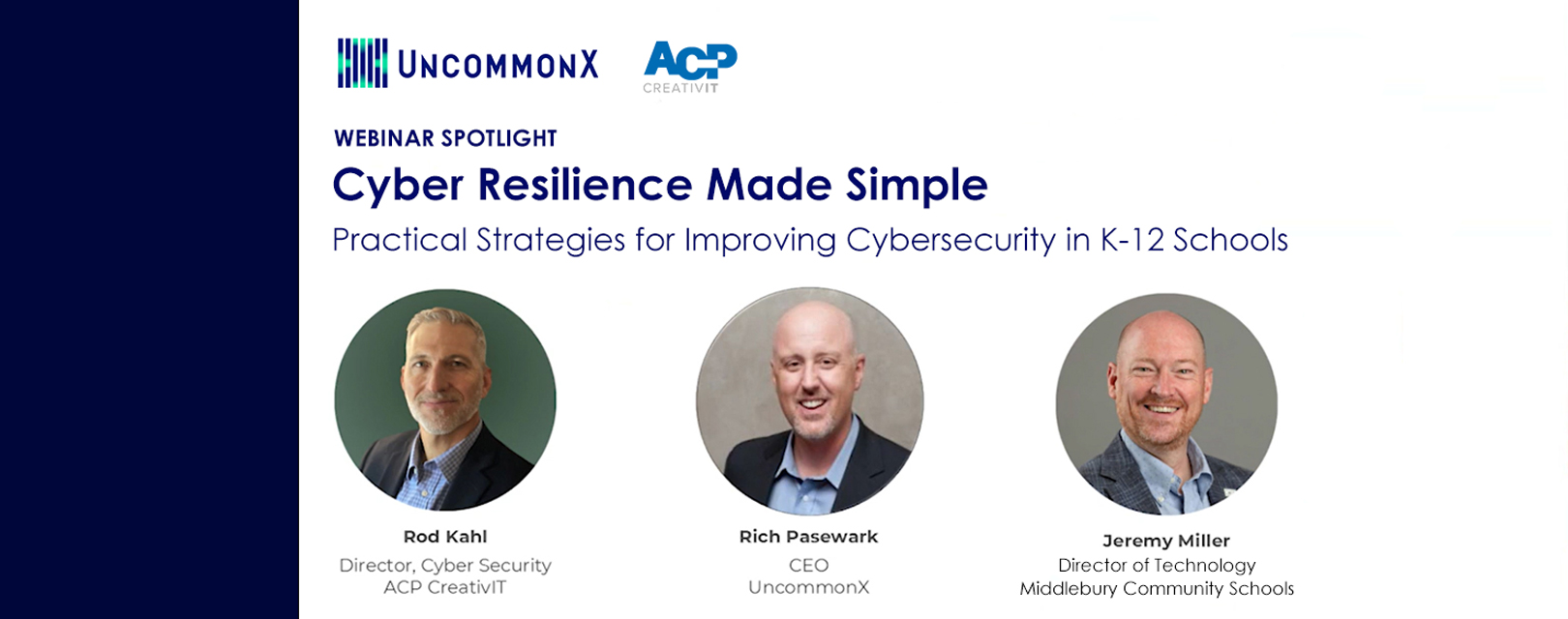WEBINAR SPOTLIGHT: Practical Strategies for Improving School Cyber Resilience
The cybersecurity landscape in K-12 schools has reached a pivotal point. Despite growing threats, many schools find themselves underprepared, with a...
Experiencing an active breach? Call us immediately at 1-866-405-9156 UncommonX has experienced ZERO reportable breaches.

As the spring break approaches, it's crucial for K-12 school district IT and security teams to be on high alert. The tranquility of deserted campuses can be deceiving, masking the lurking threat of cyber attacks aiming to exploit any lapse in vigilance.
Schools are typically empty and staff may be operating on a skeleton crew, which presents a unique vulnerability. Cybercriminals exploit this lull in activity to launch data breaches and ransomware attacks, capitalizing on potentially slower response times.
Reflecting on recent cyber incidents, this blog post highlights prevention strategies during a vulnerable period for school districts, and highlights a list of measures K-12 schools can take to bolster cyber defenses while staff and students are away.
Heightened Risk During Spring Break
Last year, two significant cyber attacks underscored the vulnerability of school districts during spring break. Minnesota's Rochester Public Schools, serving over 17,000 students, was compelled to shut down its network following the detection of unusual activity. The disruption led to the cancellation of classes, forcing a rapid adaptation to teaching without major technology systems.
Similarly, Alabama’s Jefferson County Schools, with a 36,000-student body, succumbed to a ransomware attack that severed internet and technology access for nearly two weeks, sparing only state testing activities. These incidents exemplify the critical need for preparedness against cyber threats that intensify during school breaks and holidays.
This year’s spring break follows a year of heightened concern about cybersecurity vulnerabilities at US school districts. According to the May 2023 CoSN State of EdTech Leadership report, cybersecurity remains respondents’ top priority for the fifth year in a row. However, 66 percent of school districts do not have a full-time cybersecurity position, and more than one in five have no funding for cybersecurity defense.
Implementing Proactive Cybersecurity Measures
While many K-12 schools find themselves struggling to keep pace with the growing threat of cyber attacks, there are preliminary measures IT and security teams can take to begin building cyber resilience, especially during times when networks are most vulnerable, like spring break.





A Time for Staff Rest, Not Cyber Risk
As schools gear up for spring break, UncommonX stands at the ready. Its suite of cybersecurity solutions ensures school districts are equipped to anticipate cyber threats, maintain a secure network and build a more resilient digital learning environment.
This was the case recently when an UncommonX school district customer experienced a ransomware attack. Fortunately, the immediate visibility delivered by UncommonX and its 24/7 SOC found where the attack started and sped up the start of remediation.
With just 10 days until students and teachers were due to arrive back on campus, the UncommonX 24/7 SOC team and the district’s IT team worked to successfully rebuild the network and put protections in place.
By offering a combination of advanced threat detection, response capabilities and 24/7 monitoring, UncommonX MDR for education ensures that school districts of all sizes and resources can secure their networks and data effectively.
 |
Real-time threat detection: Leveraging cutting-edge technology to monitor school networks for potential threats continuously. |
 |
Expert response team: A dedicated team of cybersecurity experts ready to respond to and mitigate threats as they arise, ensuring minimal disruption to learning.
|
 |
Tailored security posture: Customizable solutions that address the specific cybersecurity challenges faced by K-12 schools, from securing student data to protecting against ransomware. |
 |
Educational support and training: Empowering school districts with the knowledge and tools necessary to foster a culture of cybersecurity awareness among staff and students. |
Let spring break serve as a timely reminder of the importance of cybersecurity preparedness. As we work toward a future where every student can learn in a secure and equitable digital environment, the collective efforts of educators, policymakers and the cybersecurity community will be paramount.
The commitment of UncommonX to safeguarding educational institutions remains unwavering. Explore the comprehensive protection UncommonX offers school districts here or reach out to hello@uncommonx.com to learn more.

The cybersecurity landscape in K-12 schools has reached a pivotal point. Despite growing threats, many schools find themselves underprepared, with a...

As the 2023/24 school year draws to a close, many districts are taking stock of the surge in cyber attacks that targeted educational institutions...

With summer break on the horizon, cyber threats are showing no signs of slowing down. In fact, several districts are using the final months of the...